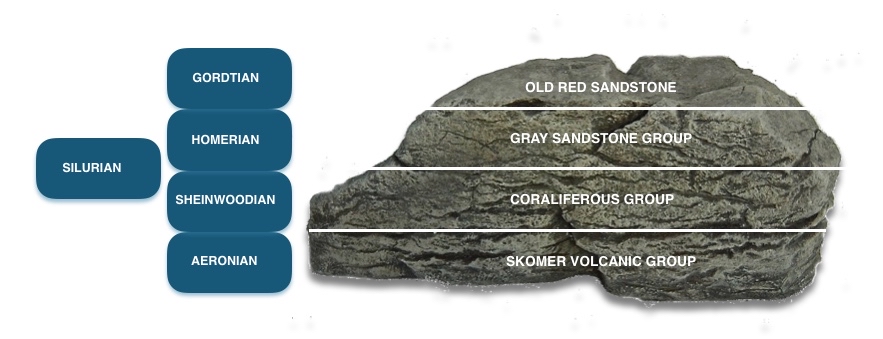Marloes Sands is a stunningly beautiful location managed by the National Trust. The scenery is fantastic, the geology is breath-taking and there are many fossils to find, including corals, brachiopods, trilobites and much more.
DIRECTIONS
♦ Parking can be found at the Marloes Sands National Trust carpark, where you can pay at a manned booth. The attendant is happy to provide information on the location, as well as an informative leaflet.
♦ From the car park, walk to your left along the road and, after about one hundred metres, you will come across a sign pointing to the right, which reads ‘Beach 700m’. Follow this downhill and you will reach the beach.
♦ Many of the rock layers at Marloes Sands are barren, but when the fossiliferous ones are located, you should be able to observe many in situ fossils and also collect from areas of scree.
♦ Ref: 51.73625°N, 5.20926°W
PROFILE INFO
FIND FREQUENCY: ♦♦♦♦♦ – Like much of the Pembrokeshire coastline, this location is a site of special scientific interest (SSSI). This means that the cliffs and larger rocks must not be damaged. However, there is plenty of scree to look through, so finds should still be plentiful. Fossils can also be observed in situ.
CHILDREN: ♦♦♦♦♦ – There is something for everyone to do at Marloes Sands. There is a massive sandy beach with crystal-clear water and many rock pools for kids to enjoy, as well as beautiful scenery, geology and fossils for the adults. The location is an ideal one for a weekend picnic.
ACCESS: ♦♦♦♦ – There is plenty of parking at the Marloes Sands National Trust car park. From here, there is an 800m walk down to the beach. Once on the beach, there is a huge area to explore.
TYPE: – Once the right rock layers are found, fossils can be observed in situ or can be collected from the large amounts of scree present.
FOSSIL HUNTING
Most fossils at Marloes Sands can be collected from scree at the base of the cliff and there is quite a variety of fossils to be found. These include brachiopods, corals, bivalves, trilobites, cephalopods and more. Perhaps of most interest are the fossil corals, which are both plentiful and diverse. Many look like pieces of charcoal with a fine ‘gilled’ internal structure. This internal structure soon crumbles away and leaves an impression of the gross morphology of the coral.
The two most productive fossiliferous areas are both to the southeast of the path to the beach. Head this way when you reach the beach and stop when you see another path that descends downwards from the cliff top. If you look at the rocks that make up the base of the cliff here, you should be able to find fossils.
The second fossiliferous area is further along the beach, perhaps 300m away from the first. Here, the layers in the cliffs are virtually perpendicular and composed of a flaky shale. Many fossils can be observed in situ in these rocks and some can be collected in the scree nearby.

GEOLOGY
Marloes Sands is a classic locality of Southern British geology and exposes Lower Palaeozoic sediments and volcanic successions.
The Silurian aged rocks at Marloes Sands are from four main geological groups:
- Skomer Volcanic Group (Aeronian c. 440.8_438.5 Mya)
These are subaerial lava flows with breccias, conglomerates, quartzites and red clayrocks. Evidence of ripples, possibly formed in shallow lagoonal conditions, might be seen at the base.
- Coraliferous Group (Sheinwoodian c. 433.4_ 430.5 Mya) and
- Gray Sandstone Group (Homerian 430.5_427.4 Mya).
These heterolithic siliciclastic units were deposited within shallow marine environments. The Gray Sandstone Formation records the transition into the overlying terrestrial deposits of the Old Red sandstone. The Coraliferous Group are the most fossiliferous, from which specimens may be collected from fallen rocks and scree.
- Old Red Sandstone (Gortian 427.4 _425.6 Mya)
Situated at the southern end of the bay, the formation comprises red floodplain mudrocks, with common calcrete. The base of the group at Marloes Sands is placed at the conformable junction of the tidal deposits of the Gray Sandstone Group and the overlying Red Cliff Formation.
Looking south, (with the sea to your right), the furthest headland in the bay is that of the Old Red Sandstone, with the Gray Sandstone Group occupying the rocks to the east of this. Walking back towards the beach access point, the next group of rocks are the Coraliferous Group, with the Skomar Volcanic Group in the cliffs nearest to the access point back to the car park.


SAFETY
Marloes Sands is a generally safe location. However, as with all coastal sites with cliffs, care must be taken to avoid falling debris and the possibility of being cut off by the tide.
EQUIPMENT
Most fossils at Marloes Sands can be collected from scree at the base of the cliff, so specialist equipment is not required. However, a camera will allow you to record the fossils you see in situ. Hammering the bedrock is not allowed.
ACCESS RIGHTS
This site is an SSSI. This Special Site of Scientific Interest, means you can visit the site, but hammering the bedrock is not permitted.
It is important to follow our ‘Code of Conduct’ when collecting fossils or visiting any site. Please also read our ‘Terms and Conditions‘
LINKS
♦ Buy Fossils, Crystals, Tools
♦ Location Discussions
♦ Deposits Magazine
♦ Join Fossil Hunts
♦ UK Fossils Network













































